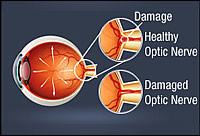Glaucoma

Glaucoma damages the optic nerve
The optic nerve is the part of the eye that carries the images we see to the brain. If your vision seems blurry, contains blank spots, or if you have eye pain or see rainbow-colored halos around lights, call your Eye Doctor right away.
Glaucoma is a leading cause of blindness in India. Early treatment can often prevent loss of sight.
Symptoms and Diagnosis



The optic nerve is made up of many nerve fibers that carry images to the brain. It's like an electric cable containing numerous wires. When glaucoma damages the optic nerve fibers, blind spots develop. If the entire nerve is destroyed, blindness results.
Primary open-angle glaucoma is the most common form of glaucoma. Typically, open-angle glaucoma has no symptoms in its early stages, and vision remains normal.
As the optic nerve becomes more damaged, blank spots begin to appear in your field of vision. You typically won't notice these blank spots in your day-to-day activities until the optic nerve is significantly damaged and these spots become large. If all the optic nerve fibers die, blindness results.
Some people are born with the iris (the colored part of the eye) too close to the drainage angle. In these eyes, which are often small and farsighted, the iris can be sucked into the drainage angle and block it completely. Since the fluid cannot exit the eye, pressure inside the eye builds rapidly and causes an acute closed-angle attack.
Regular eye examinations by your eye doctor are the best way to detect glaucoma. There are five common tests for glaucoma : tonometry and ophthalmoscopy are considered more routine, but the visual field test, pachymetry and gonioscopy are also used in diagnosis.
Some of these tests may not be necessary for everyone. These tests may need to be repeated on a regular basis to keep track of any changes in your condition.


